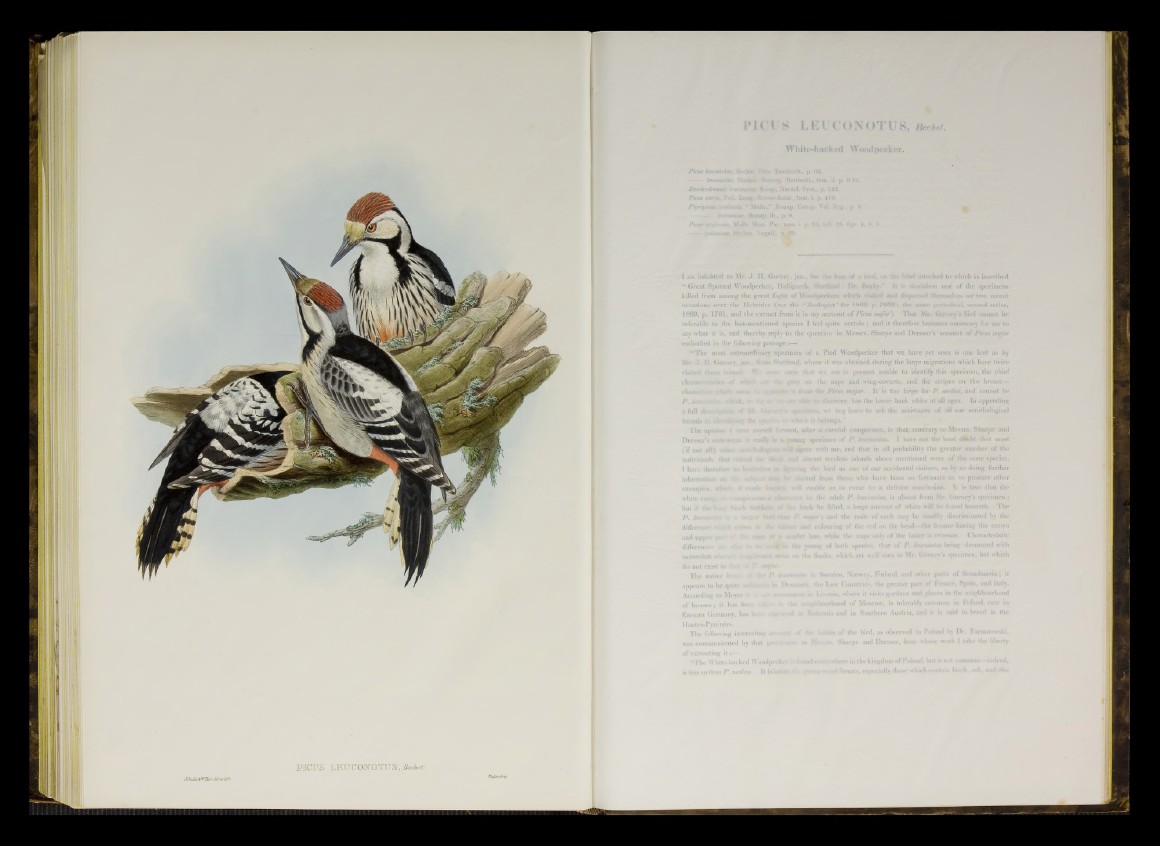
JOcuUltWIIar! Je/ ti'Uih
M O T S iK lT C 0 N Q T lT 3 ,if « A s tt
fì'alterbn/i.
White
log, Bechst On«. Taschenb., p. 66.
it« ik'chs- Naturg. Deutschl., tom. ii. p. 0 34.
• ‘ -Aemioiiis.. Kaup, Naturi. Syst., p. 142.
**H. Zoog. RssMJ-Asiat., tom. i. p. 410.
Uetuis, “ Maih.;” Botiap. Consp. Vol. Zyg , p. 8.
nwolw, Bouap. ill., p. 8.
tf. Malh Mon. Pic., tom. i. p. 02, tab 23: figs. 4, 5, fi.
ut, Brehtn, Vogelf., p. 65).
I am indebted to Mr. J . H. Gurney, jtin., ft>r the b>au uf a bird, on the attached to which is insc
“ Great Spotted Woodpecker, Halligarth, Shetland : Or. Suxby.’ It lioubtless one of the speci
killed from among the great flight of Woodpecker* which visited and diftpem*! themselves on'two r
occasions over the Hebrides (see the * Zoologist’ for 18(12, p. 7032; the same periodical, second s
1869, p. 1761, and the extract from it in my account of Picus major). That Mr. Gurney’s bird cann<
referable to the last-mentioned species I feel quite certain; and it therefore becomes necessary for i
say what it is, and thereby reply to the question in Messrs. Sharpe and Dresser’s account of Picus
embodied in the following passage:—
“ The most extraordinary specimen of a Pied Woodpecker that we have yet seen is one lent i
II . Gum
a full at Mr.
friends » idfw5rfy*«sr the spec«
The opinion I »»re wysetf
Dresser’s state«**»», it rea% u
(if not all) other ornttbofogw
I have therefore no besfta&o** i
information on the sufot'ct HM
examples, whfoh, if made kw
white m«jr. a i
but if the fowr Wm* fmO0 n
P. letmm&v h
difference ¡8|
and upper i«.-
differences <*
somewhat «w» *'
do not exist m
The native K;v.-..
appears to be quite sj*»
According to Meyer -
of houses; it has bee»>
Eastern Germany, has U.. ■. «j
Hautes-Pyrenees.
The following interesting
was communicated by that get
of extracting i t :—
“The White-backed Woodpe
is less so than P. medius. It ini
ictland, where it was obtained during the large migrations which hay
state that we. are at present unable to identify this specimen, the chief
e geev on the nape and wing-coverts, and the stripes on the breast—
?.:<■ r ft „in the Picus major. It is too large for P. medius, and cannot be
“irfe to discover, has the lower back white at all ages. In appending
■> - •;>. wc heir leave to ask the assistance of all our ornithological
mined, after a careful comparison, is that, contrary to Messrs. Sharpe and
a young specimen of P. leuconotus. I have not the least dfoiht that most
will agree with me, and that in all probability the greater mtmber of the
k almost treeless islands above mentioned were of the same species.
t.he bird as one of our accidental visitors, as
¡cited from those who have been so fortunate
i enable us to come to a definite conclusion,
r in the adult P. leuconofwt, is absent from Mr.
hack be lifted, a large amount of white will be 1
. major; and the male of each may be readily
and colouring of the red on the head—the fot
pt hue, while the nape only of the latter is cri
• voung of both species, that of P. /eucomtus
the flanks, which are well seen in Mr. Gurney'
ttu is Sweden, Norway, Finland, and other pa
.¡rK, the Low Countries, the greater part id Fr
>ti in Livonia, where it visits gardens and place*
ix’urhboarhood of Moscow, is tolerably comm
a ftohemia and in Southern Austria, and it ii
> doing fa
i procure otl
niuated by the
dug the crown
Characteristic
oner ha
mson.
being deci »rated with
but which
tin, and Italy,
eigbbourhood
i of the bird, as observed i
Sharpe and Dresser, from
here in the kingdom of Polai
d forests, especially those wt
i Poland by Dr. Taczaoowski,
whose work I take the liberty
t>t comm
i birch.